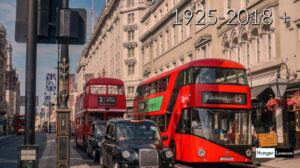
London’s First Red Bus: A Revolutionary Milestone
On this day in 1925, the first Red Buses with the enclosed roof’s appeared for the first time in London Please note: it is not
This bus started life in July 1950 making its final service run April 1979.
It is incredible these machines have been kept and a testament to those that continue to maintain them, the London Bus Museum.
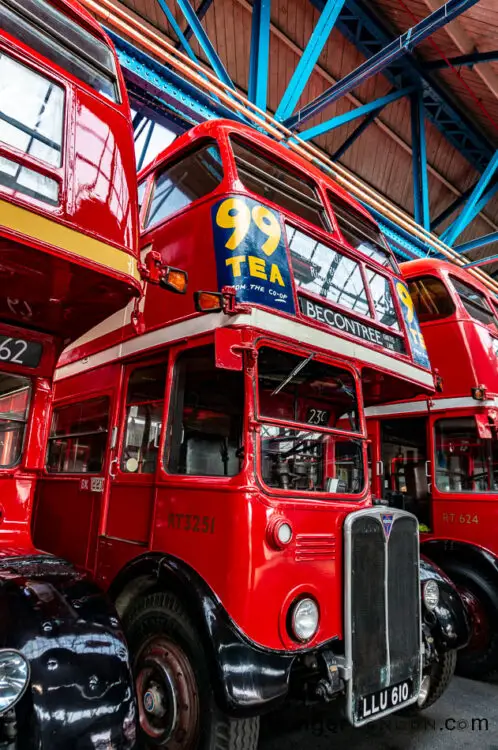
Did you used to work on these beautiful machines? Check out the comments below from those who did, and join the conversation
To all former mechanics, drivers and conductors, AEC RT & RF Buses Tweet
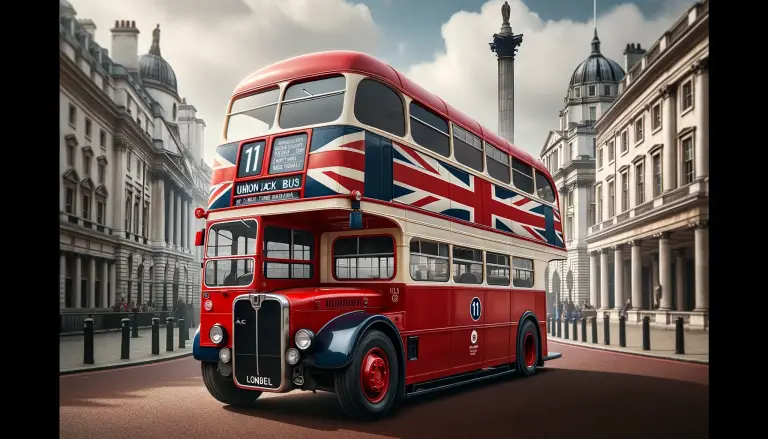
Take a peek inside the world of vintage RT London Buses, entered service 80 years ago this year. To celebrate the last journey in Barking 40 years ago in 1979, the finest collection of RT buses in the world, were driving again through the streets of Barking. 30th March 2019. Courtesy of the London Bus Museum.
This magnificent bus was designed in Great Britain in the 1930s by the British vehicle manufacturer Associated Equipment Company (AEC), who built trucks and buses from 1912 to 1979. The AEC Regent III RT prototype hit the road in 1938, named aptly as London Transport RT 1.
London Transport in this pre-war period ordered 338 of the bus type which shrank to 150 as the dark skies of world war 2 overshadowed London and the rest of the world.
The cost of a brand new Regent III RT bus: Price tag of £4000 pounds including the seats and AEC engine.
The very first pre-war RT went into service in 1939 and the last (RT624) came out of London Transport service in 1979. Built with an ACE engine that lasted 40 years of driving.
In total, London transport received 4,674 war RT class buses built in the space of 7 years from 1947 to 1954. The very last RT, now it is preserved by Ensignbus used to operate on route 62 for Barking garage on the 7th of April 1979.
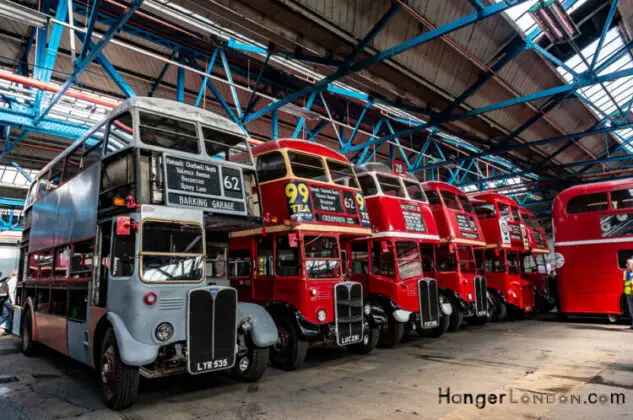
In the mid-20th century, the Regent III RT and RF buses were some of the most popular and recognisable public transport vehicles operating in the United Kingdom.
These buses were built by AEC (Associated Equipment Company) and were in service from the late 1940s to the early 1960s. The RT (Regent III) and RF (Regent III RF) were similar in many ways but had some key differences that set them apart.
The Regent III RT bus was introduced in 1947, It was a double-decker bus with a front-mounted engine and a rear platform for passengers to board and alight. The RT was a popular design and over 7,000 were produced, making it the most numerous type of bus ever used in London. It was known for its reliability and versatility and was used for both urban and suburban routes.
The Regent III RT quickly became the standard bus for the London Transport Executive. The bus was powered by an AEC 9.6 engine, there was a reference to a Leyland 0.600 power unit, comment below if you know the backstory behind the 2 engines quoted for this bus. The RT was designed to carry up to 56 passengers, with 27 seated on the upper deck and 29 on the lower deck.
One of the key features of the Regent III RT was its ability to operate on a wide range of routes. It was equally at home on busy city streets and suburban routes and could handle both flat and hilly terrain with ease. The bus was also known for its smooth ride and quiet operation, making it a popular choice for both drivers and passengers. Though modern-day passengers may have a different view, why not watch our video below and make up your own mind, about these fine buses in operation?
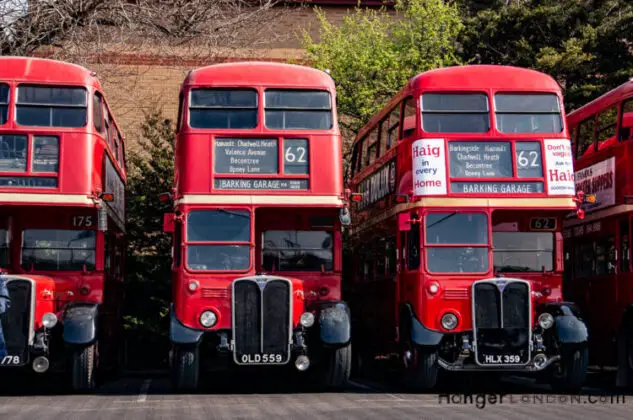
In 1950, the Regent III RF was introduced as a variant of the RT. The biggest difference was that the RF had a rear-mounted engine, which allowed for a shorter wheelbase and a more maneuverable bus. The RF was also a popular design, with over 700 produced. Like the RT, the RF was powered by an AEC engine, although a slightly smaller 9.6-liter version. The RF also had a four-speed manual gearbox and hydraulic brakes.
The Regent III RF (Regal IV Front) was a single-decker bus and was primarily used in suburban areas outside of London. The RF was smaller than the RT, but it had a similar design, with a rounded front end and aluminum body.
The RF was designed for use on rural routes and featured a higher ground clearance, a larger fuel tank, and improved suspension. The RF was also equipped with a Leyland O.600 engine, but it was detuned to provide better fuel economy.
Like the RT, the RF was a double-decker bus with a curved roof and an open platform at the rear. It could carry up to 56 passengers, with 27 seated on the upper deck and 29 on the lower deck. The RF was designed to operate on long-distance routes and was used primarily in rural areas outside of London.
Both the RT and the RF were designed with the needs of London in mind. They were sturdy and reliable buses that could withstand the demands of the busy city streets. The buses were also designed to be easy to maintain, with simple mechanical systems that could be repaired quickly and easily.
One of the most distinctive features of the RT and RF was their exterior design. The buses had a rounded front and a distinctively curved windscreen, which gave them a unique look. They were also painted in the classic London Transport red, with a white roof and silver trim.
The Regent III buses were in service for several decades, and they underwent several changes and upgrades during their lifetimes. In the 1960s, for example, many of the RT buses were converted to run on compressed natural gas (CNG) to reduce emissions.
Today, the Regent III RT and RF buses are remembered as icons of mid-20th-century British transportation. They are still celebrated by enthusiasts and collectors, who work to preserve and restore these classic vehicles for future generations to enjoy.
Despite its many advantages, the Regent III RT and RF were eventually phased out of service in the late 1960s and early 1970s. The buses were replaced by newer, more modern designs that were better suited to the changing needs of public transport. The last RT bus was retired from service in London in 2005, and the last RF bus was retired in the early 1980s. However, the Regent III RT and RF will forever remain an important part of British transport history and are fondly remembered by many who rode on them during their heyday.
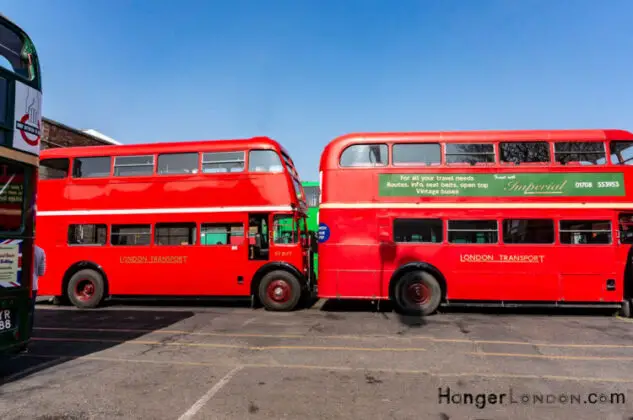
London Transport was not the only recipient of RT buses, during the 1940s and 1950s RT chassis were sold to Glasgow, Rhonda, Aberdeen, West Riding, Halifax, Grimsby, Birmingham, Devon, Coventry, and St Helens. Between 1946 to 1951 some 101 RT chassis were delivered to 10 other operators
The Glasgow Corporation, single RT bus; reg: DGB 371, was meant to appear at the commercial vehicle show of 1939, but unfortunately, the show got cancelled due to the outbreak of world war 2.
The RT buses outside of London, not only carried different liveries but also carried different designed bodies, from coach works such as Weymann, Roe, Northern Counties, Park Royal, and Metro-Cammell.
For more research and photographs on this particular topic, please take a look at this site RT Buses outside London
Today, the RT and RF buses are popular with collectors and enthusiasts. Some have been restored to their original condition and can be seen at vintage transport events and on heritage bus routes. They are a reminder of a bygone era when London’s streets were filled with these iconic buses.
Other appearances include, “Bridget Jones’s Diary,” and “Only Fools and Horses.” In each of these productions, the bus serves as a nostalgic symbol of London’s past, transporting viewers back in time to a bygone era.
No Black and White movie showing London is complete without the appearance of an AEC RT Regent bus.
The RT buses (when they were retired) were brought back for film and TV work. In the Harry Potter movie, the designers created the RT bus into a triple-decker bus known as the Knight Bus (in the Movie Harry Potter and the Prisoner of Azkaban)
Another example was when the RT bus was featured in the James Bond movie (Live and Let Die).
Another memorable appearance of the AEC Regent III RT Bus was in the 1969 film “The Italian Job.” In this movie, a group of criminals plan to steal a shipment of gold from a bank in Turin, Italy. To pull off the heist, they used three AEC Regent III RT Buses to block the traffic in the city centre, causing chaos and confusion. The scene, which features the iconic red buses driving through the narrow streets of Turin, has become one of the most famous car chases in movie history.
The Number 11 bus route in London is more than just a transportation service; it is a veritable icon, a moving witness to the city’s unfolding narrative steeped in history, culture, and unparalleled diversity. The route is steeped in history, having played a vital role in the everyday lives of Londoners for generations, while offering a picturesque sojourn through the city’s most iconic landmarks. Here we explore why the Number 11 route, graced by the red RT buses, has attained an iconic status.
Initiated in the early part of the 20th century, the Number 11 bus route has been operational for over a century, mapping London’s transformation through ages of war, peace, and cultural renaissance. The red RT buses, which adorned the route post-war, added a distinctive character, embodying the spirit of London in their vibrant hue and robust structure.
The route is a living tableau of London’s architectural marvels and historic sites. As the bus meanders through the city, passengers are treated to a visual feast featuring iconic landmarks such as the majestic Houses of Parliament, the historic St Paul’s Cathedral, and the bustling streets of Chelsea. Each stop is a doorway to a different facet of London, offering a snapshot into the city’s glorious past and vibrant present.
What makes the Number 11 route truly iconic is its accessibility and inclusivity. It has been the common man’s chariot, ferrying Londoners from all walks of life through the heart of the city. Artists, musicians, students, tourists, and even the hurried city banker have found a moment of reprieve and contemplation as the red bus journeys through London’s arteries.
Narrator of Personal Stories
Just as it has been a spectator to the city’s grand narrative, the Number 11 bus route has also been a silent keeper of countless personal stories. It has seen friendships forged, love blossomed, and dreams nurtured within its confines. Every seat holds a story, every window has framed a myriad of emotions, making it not just a bus route but a tapestry woven with threads of human experiences.
A Living, Breathing Museum
For tourists and history enthusiasts, a ride on the Number 11 route offers a cost-effective and intimate tour of London’s rich cultural and historical landscape. It is a living museum, narrating tales of grandeur, resilience, and the indomitable spirit of London through its journey past monumental landmarks that have stood as silent witnesses to the city’s unfolding saga.
The Number 11 bus route, served diligently by the iconic red RT buses, stands as more than just a pathway through London. It is a journey through time, a picturesque canvas of history, and a living testimony to the everyday lives, dreams, and aspirations of generations of Londoners. In the pulsating heart of modern London, the Number 11 route remains an enduring icon, weaving a rich narrative of the city’s past into the vibrant tapestry of its present and future, inviting one and all to become a part of London’s living, breathing narrative.
The AEC RT London Bus has a rich history and many interesting stories associated with it. The AEC RT was one of the variants of the AEC Regent III and was a double-decker bus produced jointly between AEC and London Transport 1. It was the standard red London bus in the 1950s and continued to outnumber the better-known Routemaster throughout the 1960s 1.
One interesting story about the AEC RT is how it was first designed and then replaced by AEC. For a vehicle as beloved, well-known, and emblematic of a place and time as the London double-decker bus, it sure doesn’t get as much attention these days as, say the E-Type or the Mini 2. While other double-deckers preceded them, perhaps the most widely recognized versions are the AEC Regent III RT, introduced in 1939, and the later AEC Routemaster, introduced to regular service in 1956 2. Neither were necessarily intended to remain on the road as long as they did (the RT through 1979, the Routemaster through 2005), yet thanks to numerous advances in their development—and London Transport’s refurbishment program for the buses—they stuck around long enough to become inextricably associated with the city 2.
Take a peek inside the world of vintage RT London Buses, which entered service 80 years ago this year. To celebrate the last journey in Barking 40 years ago in 1979, the finest collection of RT buses in the world, were driving again through the streets of Barking. 30th March 2019. Courtesy of the London Bus Museum.
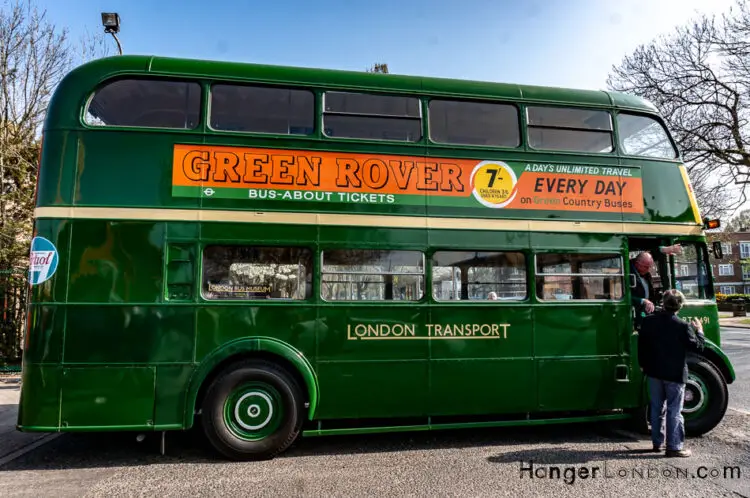
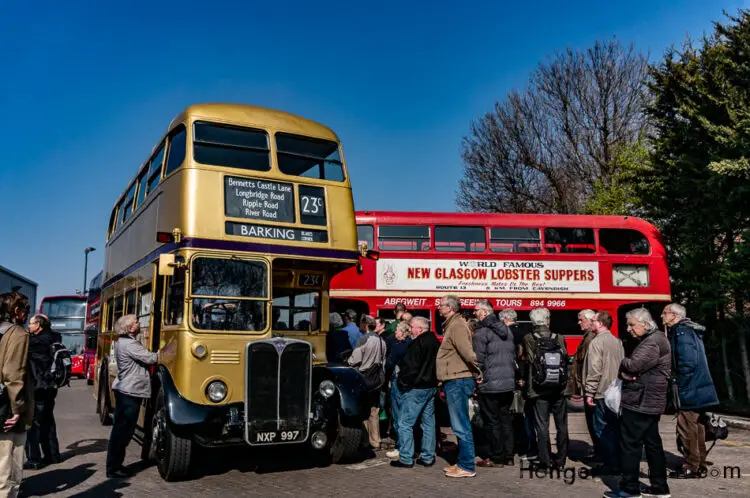
Related Posts

On this day in 1925, the first Red Buses with the enclosed roof’s appeared for the first time in London Please note: it is not
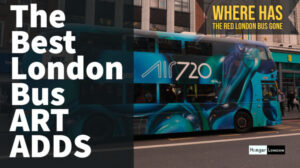
Advertising on London buses is a highly effective way to reach a diverse audience in one of the world’s most iconic cities. With over 8,600
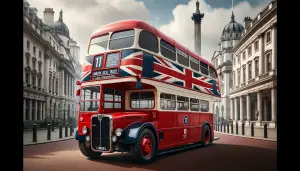
Incredible history records of the RT fleet i.e. snapshot of RT3251 LLU 610 This bus started life in July 1950 making its final service run
HangerLondon | The London Blog | Written, filmed and photographed by the London bloggers. A photographic journey mixing travels to London’s Art & Culture and delving into the capital’s rich and diverse Historical back catalog.
As an Amazon Associate I earn from qualifying purchases
Website design photography and art by Hangerlondon
What was the bus that preceded the RT in London and the Bristol Lodekka in Essex?
In London, the bus that preceded the RT was the AEC Regent III. The AEC Regent III was a type of double-decker bus produced by the Associated Equipment Company (AEC) and was in operation before the RT model.
In Essex, the bus that preceded the Bristol Lodekka was the Bristol K5G. The Bristol K5G was a double-decker bus produced by the Bristol Tramways and Carriage Company and was commonly used in various regions, including Essex, before the introduction of the Lodekka model.
I worked on RT and RF buses in 1969/71 when employed as Acting Night Chargehand Bus Mechanic at Leatherhead London Country Bus Co. Garage … can someone please remind what types of nuts / bolts were used … would they have been UNF or Whitworth? … Unlikely they were AF. I was issued with a standard tool kit comprising: hammer, brake adjuster socket (used frequently) two screwdrivers (one small one large), three open ended spanners, two ring spanners and a couple of box spanners with a bar … these few tools enabled completion of most maintenance tasks … most mechanics gradually bought their own socket sets which were very expensive … in those days there were no quality Taiwanese / Chinese tools … all socket sets on sale were of UK or European manufacture.
It’s fascinating to hear about your experience working on RT and RF buses back in the late ’60s and early ’70s at the Leatherhead London Country Bus Co. Garage.
It must have been a truly different era in terms of maintenance and tools compared to today’s standards.
In response to your question about the types of nuts and bolts used on those buses, it’s likely that a combination of UNF (Unified National Fine) and Whitworth fasteners was used.
The specific type of fasteners could have varied depending on the manufacturer’s specifications and the parts of the buses you were working on.
UNF threads were becoming more common during that period, but Whitworth threads might still have been in use in some applications.
Your description of the toolkit issued to you certainly brings a nostalgic smile to our faces.
I notice in all historic reference to the RT, no one has ever made reference to the experimental derivative; the RTC 1. This was an experimental Greenline Coach version, that did not, for whatever reason, prove successful.
It was after trials, allocated to Leatherhead Garage and worked Route 468, from Chessington Zoo to Bookham or Effingham, I can’t remember which, via Epsom, for many years from 1948.
Does anyone know more about this?
An interesting topic of the RTC 1, is the experimental Greenline Coach version of the iconic RT bus. Found some references that it operated from Leatherhead Garage and operated Route 468 from Chessington Zoo to Bookham or Effingham via Epsom provides. Could do with confirmation of that.
If anyone has more information to share about the RTC 1 or its trials, it would be a wonderful opportunity to enrich our understanding of this unique piece of transit history.
found a picture of RTC1 https://www.flickr.com/photos/23875695@N06/43722621671/
Drove RTs for the first 7 years on this job, last one was RT 2541 a sub on route 180 in August 1978. Now driving hybrids on night buses out of Plumstead. I have always harboured an ambition to drive a pre-war example.
Jeff White
Great bus the RT drove one 163 from new cross I was 21 they had just drop the she requirement from 25 parliament hill to plumstead common with my conductor Newley arrived Kiefe Cave from Barbadious (I’ll have a barley wine ) we used to split up the spare change he couldn’t count to well and have a pint at both ends where we had our break quite often in the pub ??
Good times, that’s what you call a good work lifestyle balance, a pint at both ends, brilliant!
Great memories, there is a video we shot, of these buses driving out of Barking Bus Garage. https://youtu.be/wpZNCbJXQGY
Is it me or do they drive these machines fast, Great sound, perfect size factor for the London roads.
thanks for sharing your memories Derek…do you have any old snaps from these times.
great times working on these as a mechanic during the 1960,s at Ponders End ,and Palmers Green